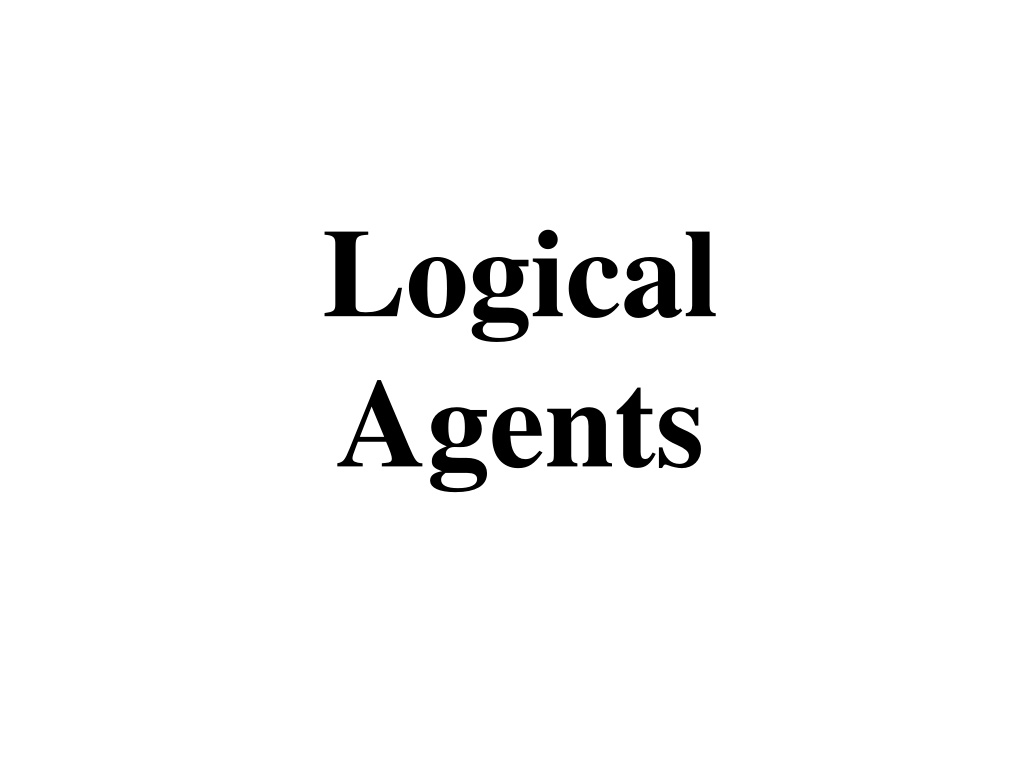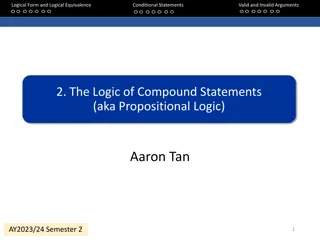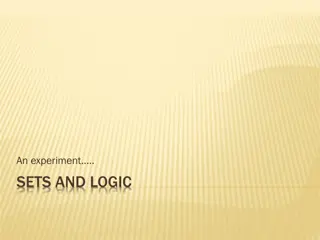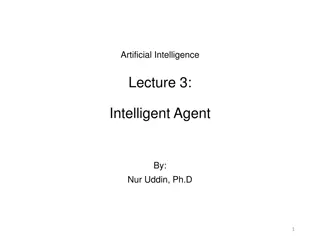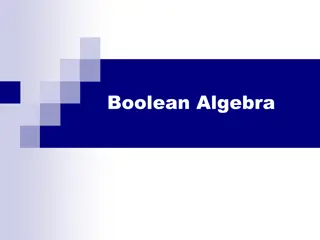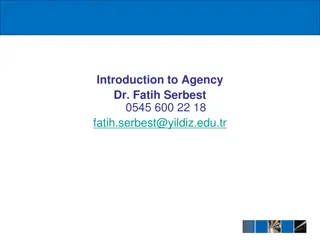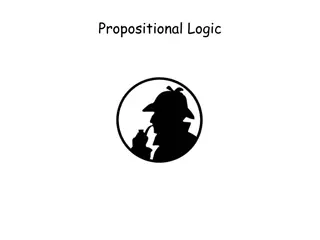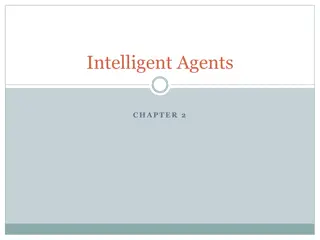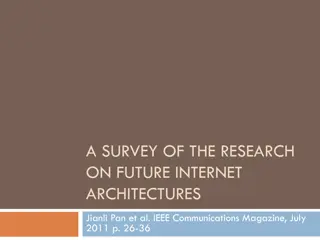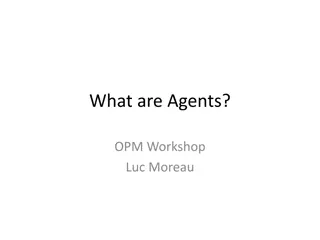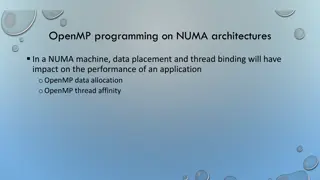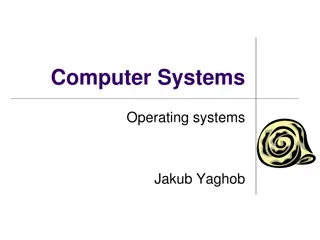Exploring Logical Agents and Architectures in Wumpus World
Explore the use of logical agents in the Wumpus World domain through three agent architectures: reflex agents, model-based agents, and goal-based agents. Understand how these agents operate in the challenging environment of the Wumpus World, where the task is to find the gold, return to starting position, and climb out of the cave. Dive into the intricacies of simple reflex agents, model-based agents, and representing change in logic within the context of intelligent agents and their decision-making processes.
Download Presentation

Please find below an Image/Link to download the presentation.
The content on the website is provided AS IS for your information and personal use only. It may not be sold, licensed, or shared on other websites without obtaining consent from the author. Download presentation by click this link. If you encounter any issues during the download, it is possible that the publisher has removed the file from their server.
E N D
Presentation Transcript
Logical Agents
Logical agents for Wumpus World We ll use the Wumpus World domain to explore three (non-exclusive) agent architectures: Reflex agents Rules classify situations based on percepts and specify how to react to each possible situation Model-based agents Construct an internal model of their world Goal-based agents Form goals and try to achieve them
AIMAs Wumpus World The agent always starts in the field [1,1] Agent s task is to find the gold, return to the field [1,1] and climb out of the cave
simple reflex agent: if-then rules Rules to map percepts into observations: b,g,u,c,t Percept([Stench, b, g, u, c], t) Stench(t) s,g,u,c,t Percept([s, Breeze, g, u, c], t) Breeze(t) s,b,u,c,t Percept([s, b, Glitter, u, c], t) AtGold(t) Rules to select action given observations: t AtGold(t) Action(Grab, t); Difficulties: Consider Climb: No percept indicates agent should climb out; position & holding gold not part of percept sequence Loops: percepts repeated when you return to a square, causing same response (unless we maintain some internal model of the world)
Model based agents Acquire and use a model of their environment Model must change over time Agent should, in general, remember past environments Agent must be able to predict how an action will/may change the environment
Representing change in Logic Representing changing world in logic is tricky One way: just change the KB Add and delete sentences from KB to reflect changes How do we remember past, or reason about changes? Situation calculus is another way Situation: snapshot of the world at some instant in time When the agent performs action A in situation S1, result is new situation S2
Situation calculus A situation is a snapshot of the world at an interval of time during which nothing changes Need way to associate assertions with a situation 1.Add situation variables to every predicate e.g., at(Agent, L) becomes at(Agent, L, s0): at(Agent, L) true in situation (i.e., state) s0 2.Add a special 2nd order predicate, holds(f, s), meaning f is true in situation s e.g., holds(at(Agent, L), s0)
Situation calculus Add new function, result(a, s), mapping situation s to new situation as result of performing action a i.e., result(forward, s) is a function returning next situation Example: The action agent-walks-to-location- y could be represented by ( x)( y)( s) (at(Agent, L1, S) onbox(S)) at(Agent, L2, result(walk(L2), S))
Deducing hidden properties From the perceptual information we obtain in situations, we can infer properties of locations l,s at(Agent, L, s) Breeze(s) Breezy(L) l,s at(Agent, L s) Stench(s) Smelly(L) Neither Breezy nor Smelly need situation arguments because pits and the Wumpus do not move around
Deducing hidden properties II Need rules relating aspects of single world state (as opposed to between states) Two main kinds of such rules: Causal rules reflect assumed direction of causality ( L1,L2,S) at(Wumpus,L1,S) adjacent(L1,L2) Smelly(L2) ( L1,L2,S) at(Pit,L1,S) adjacent(L1,L2) Breezy(L2) Systems with causal rules are model-based reasoning systems Diagnostic rules infer presence of hidden properties directly from percept-derived information, e.g. ( L,S) at(Agent,L,S) Breeze(S) Breezy(L) ( L,S) at(Agent,L,S) Stench(S) Smelly(L)
Blocks world The blocks world is a micro-world consisting of a table, a set of blocks and a robot hand Some domain constraints: Only one block can be on another block Any number of blocks can be on table The hand can only hold one block Typical representation: ontable(b) ontable(d) on(c,d) holding(a) clear(b) clear(c) Meant to be a simple model!
Representing change blocks world Frame axiomsencode what s not changed by an action E.g., moving a clear block to the table doesn t change the location of any other blocks On(x, z, s) Clear(x, s) On(x, table, Result(Move(x, table), s)) On(x, z, Result(Move (x, table), s)) On(y, z, s) y x On(y, z, Result(Move(x, table), s)) Proliferation of frame axioms becomes very cumbersome in complex domains What about color, size, shape, ownership, etc.
Qualification problem How can you characterize every effect of an action, or every exception that might occur? Putting my bread into the toaster, & pushing the button, it will become toasted after two minutes, unless The toaster is broken, or The power is out, or I blow a fuse, or A neutron bomb explodes nearby and fries all electrical components, or A meteor strikes the earth, and the world we know it ceases to exist, or
Ramification problem Nearly impossible to characterize every side effect of every action, at every level of detail When I put my bread into the toaster, and push the button, the bread will become toasted after two minutes, and The crumbs that fall off the bread onto the bottom of the toaster over tray will also become toasted, and Some of the those crumbs will become burnt, and The outside molecules of the bread will become toasted, and The inside molecules of the bread will remain more breadlike, and The toasting process will release a small amount of humidity into the air because of evaporation, and The heating elements will become a tiny fraction more likely to burn out the next time I use the toaster, and The electricity meter in the house will move up slightly, and
Knowledge engineering! Modeling the right conditions and the right effects at the right level of abstraction is difficult Knowledge engineering (creating & maintaining KBs for intelligent reasoning) is field unto itself We hope automated knowledge acquisition and machine learning tools can fill the gap: Intelligent systems should learn about conditions and effects, just like we do! Intelligent systems should learn when to pay attention to, or reason about, certain aspects of processes, depending on context. (metacognition?)
Goal-based agents Goal based agents model their goals And how their actions move them closer or father than their goals
Preferences among actions Problem: how to decide which of several actions is best E.g., in choosing between forward and grab, axioms describing when it is OK to move to a square would have to mention glitter Not modular! We can solve this problem by separating facts about actions from facts about goals This way our agent can be reprogrammed just by asking it to achieve different goals
Preferences among actions First step: describe desirability of actions independent of each other We can use a simple scale: actions can be Great, Good, Medium, Risky or Deadly Agent should always do best action it can find: ( a,s) Great(a,s) Action(a,s) ( a,s) Good(a,s) ( b) Great(b,s) Action(a,s) ( a,s) Medium(a,s) ( ( b) Great(b,s) Good(b,s)) Action(a,s) ...
Preferences among actions Until it finds gold, basic agent strategy can be: Great actions: picking up gold when found; climbing out of cave with the gold Good actions: moving to square that s OK and hasn't been visited yet Medium actions: moving to a square that is OK and has already been visited Risky actions: moving to square that s not known to be deadly or OK Deadly actions: moving into a square that is known to have pit or Wumpus
Achieving one goal uncovers another Once gold is found, we must change strategies, requiring new set of action values We could encode this as a rule: ( s) Holding(Gold,s) GoalLocation([1,1]),s) We must decide how the agent will work out a sequence of actions to accomplish the goal Three possible approaches: Inference: good versus wasteful solutions Search: a problem with operators and set of states Planning: to be discussed later
Coming up next Logical inference Knowledge representation Planning
